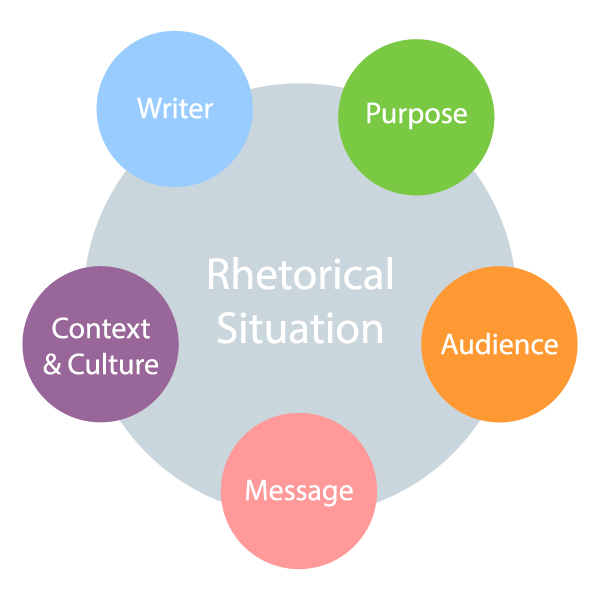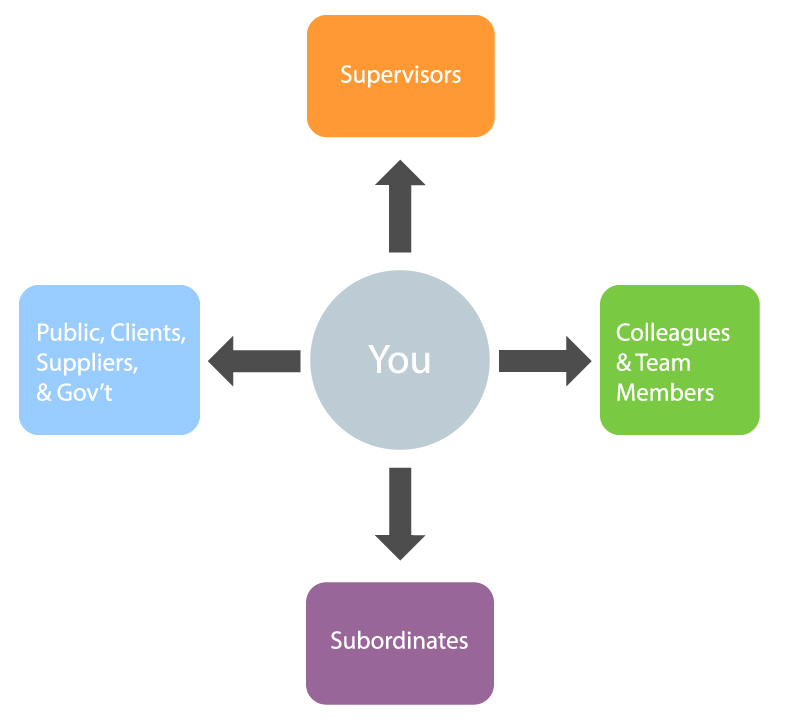15 The Rhetorical Situation
It is common knowledge in the workplace that no one really wants to read what you write, and even if they want to or have to read it, they will likely not read all of it. So how do you get your reader to understand what you need quickly and efficiently? Make sure you understand the “rhetorical situation” (Figure 1).

Figure 1: The Rhetorical Situation
The “Rhetorical Situation” is a term used to describe the components of any situation in which you may want to communicate, whether in written or oral form. To define a “rhetorical situation,” ask yourself this question: “who is talking to whom about what, how, and why?” There are five main components:
- Purpose
- Writer
- Audience
- Message
- Context/Culture
PURPOSE refers to why you are writing. Determining your purpose requires that you engage in Task Analysis — that is, determine what you hope to accomplish by writing this document. Ask yourself what you hope the reader(s) will do/think/decide or how they will behave as a result of reading the text. There are three general purposes for communication in the workplace: 1) to create a record, 2) to give or request information, and 3) to persuade.
Within those general purposes, you will find a myriad of specific purposes. For example, your purpose may be to propose an innovative solution to a specific problem. In this case, you want the reader to agree to explore the idea further, or approve funding for further research and development, which would fall under the general purpose of writing to persuade.
WRITER refers to you, the writer/creator/designer of the communication. It is important to examine your own motivation for writing and any biases, past experiences, and knowledge you bring to the writing situation. These elements will influence how you craft the message, whether positively or negatively. This examination should also include your role within the organization, as well as your position relative to your target audience.
AUDIENCE refers to your readers/listeners/viewers/users. Audience Analysis is possibly the most critical part of understanding the rhetorical situation. Consider Figure 2 below. Is your audience internal (within your company) or external (such as clients, suppliers, customers, other stakeholders)? Are they lateral to you (at the same position or level), upstream from you (management), or downstream from you (employees, subordinates)? Who is the primary audience? Who are the secondary audiences? These questions, and others, help you to create an understanding of your audience that will help you craft a message that is designed to effectively communicate specifically to them.

Figure 2: Understanding your relationship to your audience.
Keep in mind that your different audiences may also have different purposes in reading your document. Consider what their various purposes might be, and how you can best help them achieve these goals. What do they already know? What do they need to know? Considering what they are expected to do with the information you provide will help you craft your message effectively. Consider also that professional writing often has a long “life-span” – a document you write today could be filed away and reviewed months or even years down the road. Consider the needs of that future audience as well.
| Audience | Purpose for Reading |
| Executives | Make decisions |
| Supervising Experts/Managers | Advise decision makers; direct subordinates |
| Technical Experts/Co-workers | Implement decisions; advise |
| Lay People/Public/Clients | Become informed; choose options; make decisions |
Some companies develop audience profiles to help guide their communications. This is a good exercise whenever you have something to communicate, especially if the information is complex. Here are some questions to consider as part of the audience profile:
Developing an Audience Profile
- Who are your primary readers? (specific names and titles, or general roles)
- Are they above you in the organizational hierarchy? Lateral, subordinate? Outside of your organization?
- Who else might read this document? (secondary readers)
- Do you know what their attitude towards the topic is?
- How might cultural differences affect their expectations and interpretations?
- How much technical background do the readers have?
- How much do they already know about the topic?
- What situation gave rise to this document?
MESSAGE refers to the information you want to communicate. This is the content of your document. It should be aligned to your purpose and targeted to your audience. While it is important to carefully choose what content your audience needs, it is equally critical to cut out content that your audience does not need or want. “Time is money” may be a tired old cliché, but it is important to avoid wasting your audience’s time with information that is unnecessary or irrelevant to them. Your message should be professional, and expressed in an appropriate tone for the audience, purpose, and context. We will discuss aspects of using a professional style and tone in crafting your message in future chapters.
CONTEXT refers to the situation that creates the need for the writing. In other words, what has happened or needs to happen that creates the need for communication? The context is influenced by timing, location, current events, and culture, which can be organizational or social. Ignoring the context for your communication could result in awkward situations, or possibly offensive ones. It will almost certainly impact your ability to clearly and credibly convey your message to your audience.
Attributions
This chapter is adapted from Technical Writing Essentials by Susan Last and is used under a CC-BY 4.0 International license.
